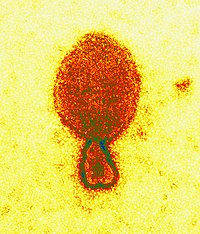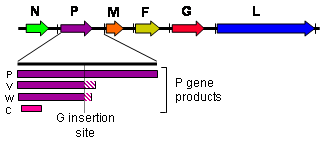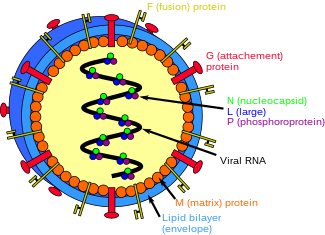Henipavirus
| Henipavirus | ||||||||||||||||||
|---|---|---|---|---|---|---|---|---|---|---|---|---|---|---|---|---|---|---|

Colored TEM image of a Hendra virus (approx. 300 nm in length) |
||||||||||||||||||
| Systematics | ||||||||||||||||||
|
||||||||||||||||||
| Taxonomic characteristics | ||||||||||||||||||
|
||||||||||||||||||
| Scientific name | ||||||||||||||||||
| Henipavirus | ||||||||||||||||||
| Left | ||||||||||||||||||
|
Henipavirus is a genus of enveloped viruses from the Paramyxoviridae family, which (as of November 2018)comprisesfive species . Thegeneric name was formedfrom the name for two of these types of virus, the Hen dra virus and the Nipa h virus .
The species of the genus Henipavirus differ from other members of the Paramyxoviridae in particular by a genome that is about 3000 nt longer and very long non-coding regions ( UTR : untranslated region ) at the 5 'and 3' ends of the RNA strand. The viruses have a membrane protein G for recognizing the target cell, which, in contrast to most paramyxoviruses, has no hemagglutinin or neuraminidase activity.
Biological properties

The species of the genus Henipavirus infect fruit bats of the genus Pteropus in Australia and Southeast Asia ( Malaysia , Cambodia ) and the palm bat ( Eidolon helvum ) in Africa . They also have their ecological reservoir here and are responsible for some locally limited outbreaks in domestic animals (especially horses and pigs) and humans, to whom they are transmitted through droplet infection or inhalation of aerosols containing urine. The infection has a high mortality rate because Nipah- and Hendra virus in addition to pneumonia , a encephalitis can cause.
Systematics
According to ICTV (international Committee on Taxonomy of Viruses) as of November 2018, the Henipaviruses are as follows:
- Genus henipavirus
- Species Cedar henipavirus ( Cedar Virus , CedV)
- Species Ghanaian bat henipavirus ( Kumasi virus , KV)
- Species Hendra henipavirus ( Hendra virus , HeV, formerly incorrectly called Equines Morbillivirus ) - pneumonia , encephalitis
- Species Mojiang henipavirus ( Mòjiāng virus , MojV)
- Species Nipah henipavirus ( Nipah virus , NiV) - pneumonia , encephalitis
literature
- David M. Knipe, Peter M. Howley, et al. (Ed.): Fields' Virology, 4th edition. Philadelphia 2001
- RA Lamb et al .: Genus Henipavirus . In: CM Fauquet, MA Mayo et al .: Eighth Report of the International Committee on Taxonomy of Viruses. London / San Diego, 2004 p. 663
Web links
- Genus Henipavirus. NCBI
- Dezhong Xu, Huimin Sun, Haixia Su, Lei Zhang; Jingxia Zhang, Bo Wang, Rui Xu: SARS coronavirus without reservoir originated from an unnatural evolution, experienced the reverse evolution, and finally disappeared in the world , in: Chinese Medical Journal, Volume 127, No. 13, July 5, 2014, p . 2537-2542, doi: 10.3760 / cma.j.issn.0366-6999.20131328
Individual evidence
- ↑ ICTV Master Species List 2018b.v2 . MSL # 34, March 2019
- ↑ a b ICTV: ICTV Taxonomy history: Akabane orthobunyavirus , EC 51, Berlin, Germany, July 2019; Email ratification March 2020 (MSL # 35)
- ↑ Lin-Fa Wang, Meng Yu, Eric Hansson, L. Ian Pritchard, Brian Shiell, Wojtek P. Michalski, Bryan T. Eaton: The exceptionally large genome of Hendra virus: support for creation of a new genus within the family Paramyxoviridae. In: Journal of Virology , 2000, 74, pp. 9972-9979
- ↑ L.-F. Wang, BH Harcourt, M. Yu, A. Tamin, PA Rota, WJ Bellini, BT Eaton: Molecular biology of Hendra and Nipah viruses . In: Microbiology and Infection , 2001, 3, pp. 279-287, PMID 11334745
- ↑ S. Wong, S. Lau, P. Woo, KY Yuen: Bats as a continuing source of emerging infections in humans . In: Reviews in Medical Virology , October 16, 2006, PMID 17042030
- ↑ KB Chua: Nipah virus outbreak in Malaysia . In: Journal of Clinical Virology , 2003, 26 (3), pp. 265-275, PMID 12637075
- ↑ ICTV Master Species List 2018a v1. ICTV , MSL including all taxa updates since the 2017 release. Fall 2018 (MSL # 33).

